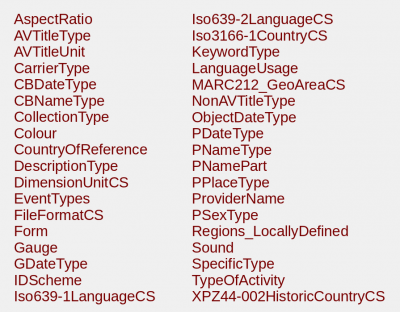Difference between revisions of "Where to look for suitable vocabularies"
From filmstandards.org
| Line 4: | Line 4: | ||
In a syntax definition (also known as ''grammar''), each element denotes a class of vocabulary items. In cases where the element has the syntactical role of a noun or adjective, this class will be referred to as '''type vocabulary'''. If the class members are expected to be verbs or verb phrases (including all constructs containing the verb ''to be''), then we speak of a '''relationship vocabulary'''. And finally, where the element denotes a class of ''named entities'' (e.g. persons, product names, etc.), we use the term '''name authority file''', a concept borrowed from librarianship. | In a syntax definition (also known as ''grammar''), each element denotes a class of vocabulary items. In cases where the element has the syntactical role of a noun or adjective, this class will be referred to as '''type vocabulary'''. If the class members are expected to be verbs or verb phrases (including all constructs containing the verb ''to be''), then we speak of a '''relationship vocabulary'''. And finally, where the element denotes a class of ''named entities'' (e.g. persons, product names, etc.), we use the term '''name authority file''', a concept borrowed from librarianship. | ||
| + | |||
| + | {| style="float: right; border: 1px solid #BBB; margin: .46em 0 0 .2em;" | ||
| + | |- | ||
| + | | valign="top" width="405px" |[[File:Efg-type-vocs.png|400px]]<br /> | ||
| + | <span style="font-size:8pt"> | ||
| + | </span> | ||
| + | |||
| + | | valign="top" width="405px" | | ||
| + | This is a list of '''type vocabularies''' for the European Film Gateway (EFG) metadata schema. These vocabularies were collected from various sources, including existing filmographic databases. | ||
| + | |||
| + | EFG uses these vocabularies as ''mapping targets'', i.e. as a common representation for data values expressed in locally defined vocabularies of contributing film archives. | ||
| + | |} | ||
| + | |||
{| style="float: right; border: 1px solid #BBB; margin: .46em 0 0 .2em;" | {| style="float: right; border: 1px solid #BBB; margin: .46em 0 0 .2em;" | ||
| Line 14: | Line 27: | ||
* [http://www.ebu.ch/metadata/cs/ EBU metadata coding schemes download page] | * [http://www.ebu.ch/metadata/cs/ EBU metadata coding schemes download page] | ||
* [http://www.schemaweb.info/default.aspx SchemaWeb: A directory of RDF-based schemas and vocabularies] | * [http://www.schemaweb.info/default.aspx SchemaWeb: A directory of RDF-based schemas and vocabularies] | ||
| − | |||
| − | |||
| − | |||
| − | |||
| − | |||
| − | |||
| − | |||
| − | |||
| − | |||
| − | |||
| − | |||
Revision as of 21:11, 12 June 2011
From the TC 372 Workshop Compendium
Strictly speaking, even a metadata schema such as EN 15907 is a vocabulary. It provides us with names and definitions of entities. In addition, it defines ways in which these entities can be combined in order to create meaningful statements. This is its role as a syntax definition.
In a syntax definition (also known as grammar), each element denotes a class of vocabulary items. In cases where the element has the syntactical role of a noun or adjective, this class will be referred to as type vocabulary. If the class members are expected to be verbs or verb phrases (including all constructs containing the verb to be), then we speak of a relationship vocabulary. And finally, where the element denotes a class of named entities (e.g. persons, product names, etc.), we use the term name authority file, a concept borrowed from librarianship.
| • Previous: Common pitfalls in vocabulary selection • Up: Contents • Next: Titles and proper names • |
